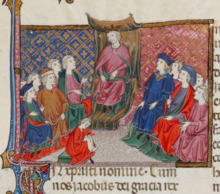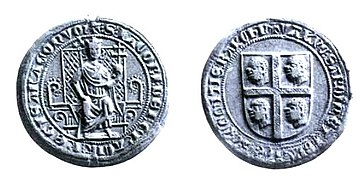James II of Aragon
| James II | |
|---|---|
Valencia | |
| Died | 2/5 November 1327 (aged 60) Barcelona |
| Burial | |
| Spouses | |
| Issue among others... |
|
| House | House of Barcelona |
| Father | Peter III of Aragon |
| Mother | Constance of Sicily |
James II (Catalan: Jaume II; Aragonese: Chaime II; 10 April 1267 – 2 or 5 November 1327), called the Just,
Born at
Reign
1285–1298
James succeeded his father as King of Sicily in 1286, being crowned in Palermo.[3] In response, Pope Honorius IV excommunicated James.[3] Upon the death of his brother Alfonso III in 1291, he succeeded also to the throne of the Crown of Aragon. He spent May of that year in Catania, inspiring the local monk Atanasiu di Iaci to write the Vinuta di re Iapicu about his time there. By a peace treaty with Charles II of Anjou in 1296, he agreed to give up Sicily, but the Sicilians instead installed his brother Frederick on the throne.
Due to the fact that Frederick would not withdraw from the island, Pope Boniface VIII asked James II, along with Charles II of Naples, to remove him. As an enticement to do this the Pope invested James II with the title to Sardinia and Corsica, as well as appointing him papal gonfalonier. Because of his inability to disguise his apathy on the matter, he returned to Aragon. Frederick reigned there until his death in 1337.[4]
By the Treaty of Anagni in 1295, he returned the Balearic Islands to his uncle James II of Majorca. In 1298, by the Treaty of Argilers, James of Majorca recognised the suzerainty of James of Aragon.
1298–1327

During the period that followed his return to Aragon, James II wanted to gain access to the Muslim world in the south, from which Castile restricted Aragon. In order to achieve this goal, and assisted by his Admiral Don Bernat de Sarrià, Baron of Polop, he formed an alliance with the enemies of the adolescent king of Castile, Ferdinand IV. James II wanted Murcia in order to give his kingdom access to Granada. The allied forces entered from all directions in 1296, where James II was victorious in capturing Murcia and holding it until 1304.
In 1313, James II granted administrative and political autonomy to the
James was involved in the
Writing
It was probably during his reign at Sicily (1285–1291) that James composed his only surviving piece of
James begins by comparing the Church to a ship in a storm, poorly guided by its pilot (nauchier, i.e. the Pope):
Mayre de Deu e fylha, |
Mother of God and daughter, |
The literary quality of the verses is neither astounding nor disappointing, but the song was clearly written at a moment when James was in conflict with the Papacy, perhaps with a propagandistic end, to prove his piety and fidelity to the Church if not the Papacy. The final verses ask Mary to protect him, the king, from sin:
Mayre, tu·m dona forsa |
Mother, grant me power |
Family
Marriages, concubines and children
This section needs additional citations for verification. (April 2023) |
James married four times:
—
—
- James (b. 29 September 1296 – d. Tarragona, July 1334). James renounced his right to the throne in 1319 to become a monk. He refused to consummate his marriage to Eleanor of Castille, who later become the second wife of his brother Alfonso.
- Alfonso IV of Aragon (1299 – 24 January 1336).[9] He became the King of Aragon in 1327 and ruled until his death. He married twice: first Teresa d'Entença and then Eleanor of Castile after his first wife died.
- Maria (b. 1299 – d. as a nun in Sijena, 1347), wife of Peter, son of Sancho IV of Castile.
- Juan Manuel, Prince of Villena, nephew of Alfonso X of Castile.
- Archbishop of Toledo and Tarragona in 1318, and Patriarch of Alexandriain 1328.
- Frederick I of Austria.
- Gaston I of Foix, they were parents to:
- Alphonse (b. 1332 - d. 5/7 March 1412), 1st Duke of Gandia, 1st Marquess of Villena de Castilla, 2nd Count of Ribagorza and Empúries, etc., Constable of Castile, married in 1355 Violante Ximénez de Arenós, daughter of Gonzalo Díez de Arenós, Baron of Arenós, and wife María or Juana de Cornell, had issue
- John (b. 1335, d. 1414), 2nd Count of Prades, Seneschal of Catalonia, married his sister-in-law Sancha Ximénez de Arenós, had issue
- Eleanor of Aragon, Queen of Cyprus.
- Blanche (b. 1307 – d. Barcelona, 1348), Prioress of Sixena.
- Juan Manuel, Prince of Villena
- Violante (b. Barcelona, October 1310 – d. Pedrola, 19 July 1353). She first married Philip, Despot of Romania, son of Philip I of Taranto. Her second marriage was to Lope de Luna, Lord of Segorbe.
— Marie of Lusignan (1273 – April, 1319 at Tortosa, buried at Barcelona), daughter of the King Hugh III of Cyprus. They married by proxy in Santa Sophia, Nicosia, on 15 June 1315, and in person in the city of Girona, on 27 November 1315. This marriage was childless.
—
In addition to his legitimate offspring, James had three natural children born with Sicilian women:
— With Gerolda:
- Sancho (b. Sicily, 1287 – d. young?).
- Napoleón (b. Sicily, 1288 – m. 1338), Lord of Joyosa Guarda (Gioiosaguardia) and Acquafredda (in Sardinia); married a daughter of a Majorcan named Guillermo Robert.
— With Lucrecia:
- James (b. Mazzara, 1291 – d. 1350), Vicario di Cagliari (1317–1341); married firstly with Jaumetta Guerau, from Majorca, and secondly with Puccia, a Sardinian woman.
Effigy
-
A diner minted at Barcelona with James II's left-facing bust on the obverse
-
Lead seal showing James II seated on a throne and holding an orb, with the Sardinian coat-of-arms on the reverse
-
Tomb effigy of James in the royal monastery of Santes Creus
Notes
References
- ^ Hohenstaufen 1961, p. 495.
- ^ Hillgarth 1972, p. 346.
- ^ a b Watt 1999, p. 155.
- ^ Constable & Zurro 1997, p. 394.
- ^ Turell 2001, p. 142.
- ^ de Riquer 1964, p. 172-173.
- ^ d'Avray 2015, p. 95.
- ^ Burgtorf 2008, p. 632.
- ^ Lodge 1924, p. 278.
Sources
- Burgtorf, Jochen (2008). The Central Convent of Hospitallers and Templars: History, Organization, and Personnel (1099/1120-1310). Brill.632
- Constable, Olivia Remie; Zurro, Damian, eds. (1997). Medieval Iberia: Readings from Christian, Muslim, and Jewish Sources. University of Pennsylvania Press.
- d'Avray, David (2015). Papacy, Monarchy and Marriage 860–1600. Cambridge University Press.
- Del Estal, Juan Manuel (2009). Itinerario de Jaime II de Aragón (1291-1327). (in Spanish). Zaragoza: Institución Fernando el Católico, 2009.
- Hillgarth, J. N. (1972). "Review of The Rise of the Aragonese-Catalan Empire, 1200–1350 by J. Lee Shneidman". Speculum. 47 (2 Apr). JSTOR 2856725.
- Hinojosa Montalvo, José (2006). Jaime II y el esplendor de la Corona de Aragón. (in Spanish). Donostia-S. Sebastián: Editorial Nerea 2006.
- Hohenstaufen, Frederick II (1961). The Art of Falconry. Translated by Wood, Casey A.; Fyfe, F. Marjorie. Stanford University Press.
- Lodge, Eleanor Constance (1924). The End of the Middle Age, 1273-1453. Methuen & Company Limited.
- Scarlata, Maria (ed.). Carte reali diplomatiche di Giacomo II d'Aragona (1291-1327) riguardanti l'Italia. (in Italian, Spanish, and Latin). Palermo: Società siciliana per la storia patria, 1993.
- Turell, M. Teresa, ed. (2001). Multilingualism in Spain : Sociolinguistic and Psycholinguistic aspects of linguistic minority groups ([Online-Ausg.] ed.). Clevedon [u.a.]: Multilingual Matters. ISBN 9781853594915. Retrieved 19 August 2015.
- de Riquer, Martín (1964). Història de la Literatura Catalana. Vol. 1. Edicions Ariel.
- Watt, J.A. (1999). "The papacy". In Abulafia, David; McKitterick, Rosamond (eds.). The New Cambridge Medieval History. Vol. 5, C.1198–c.1300. Cambridge University Press.
Further reading
- VanLandingham, Marta. Transforming the State: King, Court and Political Culture in the Realms of Aragon (1213–1387). Leiden [Netherlands]: Brill, 2002. ISBN 9004127437



